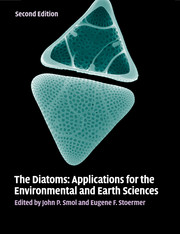Book contents
- Frontmatter
- Contents
- List of contributors
- Preface
- Part I Introduction
- Part II Diatoms as indicators of environmental change in flowing waters and lakes
- Part III Diatoms as indicators in Arctic, Antarctic, and alpine lacustrine environments
- Part IV Diatoms as indicators in marine and estuarine environments
- 15 Diatoms and environmental change in large brackish-water ecosystems
- 16 Applied diatom studies in estuaries and shallow coastal environments
- 17 Estuarine paleoenvironmental reconstructions using diatoms
- 18 Diatoms on coral reefs and in tropical marine lakes
- 19 Diatoms as indicators of former sea levels, earthquakes, tsunamis, and hurricanes
- 20 Marine diatoms as indicators of modern changes in oceanographic conditions
- 21 Holocene marine diatom records of environmental change
- 22 Diatoms as indicators of paleoceanographic events
- 23 Reconsidering the meaning of biogenic silica accumulation rates in the glacial Southern Ocean
- Part V Other applications
- Part VI Conclusions
- Glossary, acronyms, and abbreviations
- Index
- References
15 - Diatoms and environmental change in large brackish-water ecosystems
from Part IV - Diatoms as indicators in marine and estuarine environments
Published online by Cambridge University Press: 05 June 2012
- Frontmatter
- Contents
- List of contributors
- Preface
- Part I Introduction
- Part II Diatoms as indicators of environmental change in flowing waters and lakes
- Part III Diatoms as indicators in Arctic, Antarctic, and alpine lacustrine environments
- Part IV Diatoms as indicators in marine and estuarine environments
- 15 Diatoms and environmental change in large brackish-water ecosystems
- 16 Applied diatom studies in estuaries and shallow coastal environments
- 17 Estuarine paleoenvironmental reconstructions using diatoms
- 18 Diatoms on coral reefs and in tropical marine lakes
- 19 Diatoms as indicators of former sea levels, earthquakes, tsunamis, and hurricanes
- 20 Marine diatoms as indicators of modern changes in oceanographic conditions
- 21 Holocene marine diatom records of environmental change
- 22 Diatoms as indicators of paleoceanographic events
- 23 Reconsidering the meaning of biogenic silica accumulation rates in the glacial Southern Ocean
- Part V Other applications
- Part VI Conclusions
- Glossary, acronyms, and abbreviations
- Index
- References
Summary
Introduction
Classification of brackish waters
Brackish waters comprise a range of exclusive habitats that can be subdivided into three major categories: transition zones between freshwater and marine habitats, transition zones between hyperhaline water and marine habitats, and inland waters without marine water exchange. Salinities of brackish-water habitats vary from relatively stable (e.g. some large saline lakes; see Fritz et al., this volume) to extremely instable in time and space (e.g. estuaries bordering tidal seas; see Trobajo & Sullivan, this volume). In the past, many efforts have been made to classify brackish waters according to salinity and the occurrence of biological species (Kolbe, 1932; Segerstråle, 1959; den Hartog, 1964). The more detailed such classifications are, the less well they appear to fit with all types of brackish waters. Based on salinity, defined as the total concentration of ionic components in g per kg water, generally accepted approximate limits are: limnetic (freshwater) <0.5 practical salinity units (psu) = parts per thousand (ppt), oligohaline 0.5–5 psu, mesohaline 5–18 psu, polyhaline 18–30 psu, euhaline 30–40 psu, hyperhaline 40 psu (known as the “Venice System”: Anonymous, 1959).
Large brackish-water ecosystems
Earth's longest salinity gradient comprises the continental microtidal Baltic Sea (Leppäranta & Myrberg, 2009: surface area 377,000 km2, water volume 21,000 km3, mean depth 58 m, maximum depth 459 m) and its transition area to the North Sea.
- Type
- Chapter
- Information
- The DiatomsApplications for the Environmental and Earth Sciences, pp. 287 - 308Publisher: Cambridge University PressPrint publication year: 2010
References
- 11
- Cited by



